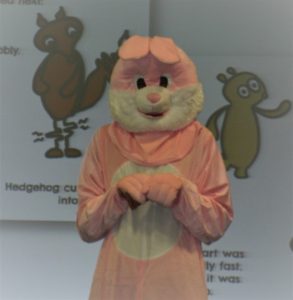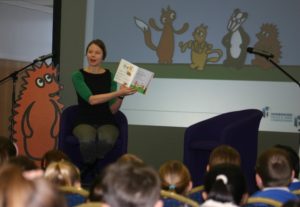A six-foot rabbit is on stage, acting out the motions of the Flippety Floppety Rabbit as I read them aloud. “Imagine you are holding two carrots” I say. “Squeeze them tight… and now let them flop, like a flippety floppety rabbit”. The rabbit mimes squeezing his paws tightly shut and 50 children watching do the same. This is not a normal day for me.
We are at Hull Library, where Victim Support are launching a project to support child victims of burglary. They have seen the effect a break-in can have, ranging from nightmares to poor performance at school, and want to do something about it. They already support victims of crime, but their new strategy includes pro-actively asking adult victims of burglary whether the children in the house might need extra support.
The Humberside team have asked me to attend the event, as they will be using my book Who’s Been in our Tree? in their support packs for children. The children from two local schools seem intrigued by the unusual subject matter, captivated by the large cardboard cut-outs of characters from the book. It’s also exciting for me to see Fox, Badger, Squirrel and Hedgehog looking decidedly larger than life, as I remember them when they were but a pencil scribble on a scrap of paper.
I read the book to the children. They listen attentively and are bursting with questions when I get to the end: What kind of animals are the burglars? Why did I choose birds to be the police? Why did I choose animals at all? Did I have any help from a psychologist to create the plans the animals use to make themselves feel better after the burglary? Believe it or not, these are all questions from 8- and 9-year olds. Luckily the answer is ‘yes I did have help from a child psychologist’! One boy timidly puts up his hand and asks how the burglars got in the tree. It is clear from the worried look on his face that he is thinking about how burglars might get into his own house. The tables have turned and I am now the rabbit in the headlights, stuck for an answer. I want to tell the truth about crime, but I don’t want to add to his worry. In the end I tell him that we don’t know how the burglars in the story got in the tree, but we can all make our houses safe by keeping doors and windows locked. I also reassure him that burglaries don’t happen very often, and he seems relieved.
His tricky question reminds me of why we often don’t talk to children about things in life that are difficult or scary. It’s hard to get the balance right between preparing and scaring them. Often it feels easier just not to talk about it. I’m convinced though, that the children we spoke to today will be better equipped to deal with their own emotions when they or people around them experience a burglary, another type of crime, or even the stresses and strains of everyday life. They know how to do the Flippety Floppety Rabbit for one thing, an evidence-based relaxation exercise that they can use in any situation. I admire the schools, the library and Victim Support Humberside for being brave enough to have these difficult conversations. Hopefully, it’s a little step towards those children knowing how to look after their mental health, to support their friends, and where to turn when they need help.
Website: www.whosbeeninourtree.com
Twitter: @WBIOT
A 5 minute video of the day, filmed by That’s TV Humber.
Who’s Been in Our Tree? is available to buy online at Amazon and other online book retailers.




